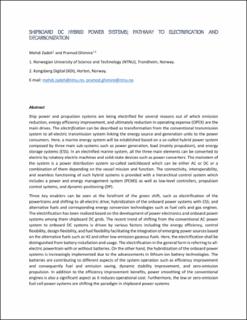| dc.description.abstract | Ship power and propulsion systems are being electrified for several reasons out of which emission reduction, energy efficiency improvement, and ultimately reduction in operating expense (OPEX) are the main drives. Electrification can be described as the transformation from the conventional transmission system to an all-electric transmission system linking the energy source and generation units to the power consumers. Here, a marine energy system will be established based on a so-called hybrid power system composed of three main sub-systems such as power generation, load (mainly propulsion), and energy storage systems (ESSs). In an electrified marine system, all three main elements can be converted to electric by rotatory electric machines and solid-state devices such as power converters. The main stem of the system is a power distribution system so-called switchboard which can be either AC or DC or a combination of them depending on the vessel's mission and function. The connectivity, interoperability, and seamless functioning of such hybrid systems are provided with a hierarchical control system, which includes a power and energy management system (PEMS) as well as low-level controllers, propulsion control systems, and dynamic positioning (DP).
Three key enablers can be seen at the forefront of the green shift, such as electrification of the powertrains and shifting to all-electric drive; hybridization of the onboard power systems with ESS; and alternative fuels and corresponding energy conversion technologies such as fuel cells (FCs) and gas engines. The electrification has been realized based on the development of power electronics and onboard power systems among them shipboard DC grids. The recent trend of shifting from the conventional AC power system to onboard DC systems is driven by various factors including energy efficiency, control flexibility, design flexibility, and fuel flexibility facilitating the integration of emerging power sources based on alternative fuels, such as H 2 and other low-emission gaseous fuels. Here, electrification shall be distinguished from battery installation and usage. Electrification in the general form is referring to an all-electric powertrain with or without batteries. On the other hand, the hybridization of onboard power systems is increasingly implemented due to the advancements in lithium-ion battery technologies. The batteries are contributing to different aspects of the system operation such as efficiency improvement and consequently fuel and emission saving, dynamic stability improvement, and zero-emission propulsion. In addition to the efficiency improvement benefits, power smoothing of conventional engines is also a significant aspect as it reduces operational costs. Furthermore, the low or zero-emission FC power systems are shifting the paradigm in shipboard power systems.
This chapter discusses watercraft systems from the perspective of power and propulsion system architectures and topologies. Furthermore, the strategies of control and load sharing are discussed mainly relevant to DC hybrid power systems. Besides, a few case studies are given to elaborate on the efficiency aspect of the onboard DC power system. | en_US |
